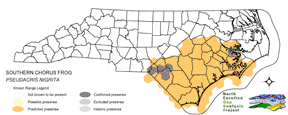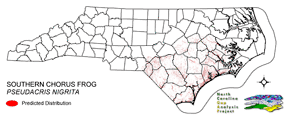
| Taxa: |
| Order: |
| Family: |
| Amphibia |
| Anura |
| Hylidae |
| NatureServe Global Rank: |
| NatureServe State (NC) Rank: |
| G5 |
| S5 |
| Federal Status: |
| NC State Status: |
| --- |
| --- |


| Land Unit |
| US Fish & Wildlife Service |
| US Forest Service |
| US National Park Service |
| US Department of Defense |
| NC State Parks |
| NC University System |
| NC Wildlife Res. Com. |
| NC Forest Service |
| NC Div. of Coastal Mgmt. |
| Local Governments |
| Non-Governmental Org. |
| Other Public Lands |
| Private Lands |
| GAP Status 1-2 |
| All Protected Lands |
| Statewide |
| Hectares |
| 337.50 |
| 5,745.96 |
| 20,530.71 |
| 5.40 |
| 885.51 |
| 1,599.12 |
| 5,778.63 |
| 1,580.94 |
| 7.20 |
| 35.64 |
| 859.50 |
| 77.40 |
| 211,892.13 |
| 5,523.57 |
| 37,286.46 |
| 249,335.64 |
| Acres |
| 833.98 |
| 14,198.57 |
| 50,732.48 |
| 13.34 |
| 2,188.14 |
| 3,951.51 |
| 14,279.30 |
| 3,906.59 |
| 17.79 |
| 88.07 |
| 2,123.87 |
| 191.26 |
| 523,596.75 |
| 13,649.04 |
| 92,136.83 |
| 616,121.66 |
| % of Dist. on |
| Prot. Lands |
| 0.9 % |
| 15.4 % |
| 55.1 % |
| < 0.1 % |
| 2.4 % |
| 4.3 % |
| 15.1 % |
| 4.2 % |
| < 0.1 % |
| 2.3 % |
| 2.3 % |
| 0.2 % |
| 0.0 % |
| 14.8 % |
| ----- |
| ----- |
| % of Dist. on |
| All Lands |
| 0.1 % |
| 2.3 % |
| 8.2 % |
| < 0.1 % |
| 0.4 % |
| 0.6 % |
| 2.3 % |
| 0.6 % |
| < 0.1 % |
| < 0.1 % |
| 0.3 % |
| < 0.1 % |
| 85.0 % |
| 2.2 % |
| ----- |
| ----- |
|
Primarily terrestrial, the southern chorus frog breeds in both upland and bottomland pools with grassy margins but may move into open upland forests when not breeding (Mount 1975). NATURE SERVE GLOBAL HABITAT COMMENTS: Pine flatwoods and forests, wet meadows, moist woodlands, and prairies, often near small gum or cypress ponds; in or near ponds, potholes, and ditches with grassy margins or emergent vegetation. Primarily terrestrial. Burrows into banks of ponds and ditches. Eggs and larvae develop in flooded roadside ditches and fields, margins of shallow ponds, temporary woodland pools, and bogs. Eggs are attached to vegetation. |
| Code | Name | Description | NC Natural Heritage Program Equivalent |
| 30 | Cypress-Gum Floodplain Forests | Swamps dominated by black or swamp tupelo with or without Taxodium. Seasonally to semi-permanently flooded hydrology. | Cypress-Gum Swamps |
| 78 | Pond-Cypress - Gum Swamps, Savannas and Lakeshores | Cypress dominated swamps and lakeshores. Can include bays dominated by pond cypress or shorelines of coastal plain lakes with a narrow band of cypress. | Non-riverine Swamp Forest, Natural Lakeshores (in part) |
| 67 | Wet Longleaf or Slash Pine Savanna | Wet flatwoods and pine savannas, typically dominated by longleaf pines, but slash or pond pines may be the dominant pines. | Wet Pine Flatwoods |
| 97 | Mesic Longleaf Pine | Longleaf pine woodlands without a major scrub oak component. Slash or loblolly pines may be present as well. | Mesic Pine Flatwoods |
|
Conant, R. and J. T. Collins. 1991. A field guide to reptiles and amphibians:eastern and central North America. Third edition. Houghton Mifflin Co., Boston, Massachusetts. 450 pp.
Wilson, L. A. 1995. The Land Manager's Guide to the amphibians and reptiles of the South. Chapel Hill, NC: The Nature Conservancy. Cocroft, R. B. 1994. A cladistic analysis of chorus frog phylogeny (Hylidae:PSEUDACRIS). Herpetologica 50:420-437. Conant, R. 1975. A Field Guide to Reptiles and Amphibians of Eastern and Central North America. Second Edition. Houghton Mifflin Company, Boston, Massachusetts. xvii + 429 pp. Mount, R. H. 1975. The Reptiles and Amphibians of Alabama. Auburn University Agricultural Experiment Station, Auburn, Alabama. vii + 347 pp. Behler, J. L., and F. W. King. 1979. The Audubon Society field guide to North American reptiles and amphibians. Alfred A. Knopf, New York. 719 pp. Martof, B. S., W. M. Palmer, J. R. Bailey, and J. R. Harrison, III. 1980. Amphibians and reptiles of the Carolinas and Virginia. University of North Carolina Press, Chapel Hill, North Carolina. 264 pp. Caldwell, J. P. 1987. Demography and life history of two species of chorus frogs (Anura:Hylidae) in South Carolina. Copeia 1987:114-127. Gates, W. R. 1988. PSEUDACRIS NIGRITA. Cat. Am. Amph. Rep. 416.1-416.3. |
For more information please contact them at:
NC-GAP Analysis Project
Dept. of Zoology, NCSU
Campus Box 7617
Raleigh, NC 27695-7617
(919) 513-2853
www.basic.ncsu.edu/ncgap